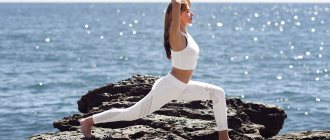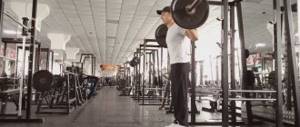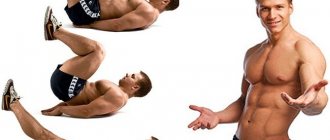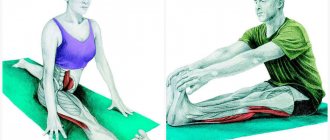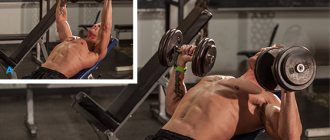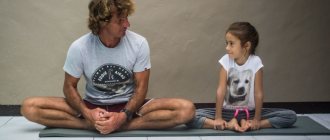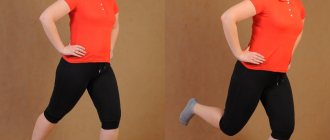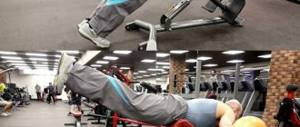Features and benefits of the exercise
Lunges with dumbbells are a complex exercise, the main load of which falls on the quadriceps, hamstrings, gluteus maximus, and calf muscles. For better coordination and maintaining balance, stabilizers are connected to them - the latissimus, rhomboids, trapezius back muscles, and abdominal muscles. When an exercise is performed with weights (dumbbells, a bar), the static load falls on the shoulders, forearms, and wrists.
Essentially, these are simply successive steps from each leg with a squat on the one that is currently in front. With a wide step, the maximum load is placed on the buttocks and hamstrings. With narrow and medium, it shifts to the quadriceps. Such lunges for girls are almost a mandatory exercise. Many of them come to gyms precisely for the sake of beautiful and elastic buttocks.
Lunges with dumbbells have the following undoubted advantages:
- minimum necessary equipment (you can work in the hall or at home);
- active burning of calories;
- improvement of coordination, general endurance;
- lower risk of injury than, for example, when doing squats with a barbell;
- greater efficiency compared to leg abduction or leg lifting in exercise machines;
- the opportunity to work on increasing the volume and compaction of muscle tissue or on relief (the exercise is also suitable for men);
- variety of variations.
The main advantage is the complex technique of performing the exercise despite its apparent simplicity. To learn to coordinate the movements and position of the upper and lower halves of the body, you have to spend a lot of time and effort. Therefore, you need to start practicing with an experienced instructor; a self-mastered technique exercise may turn out to be far from quality standards.
Mastering the correct technique is important. This is the only way the movement is anatomically natural and the likelihood of injury is reduced to almost zero. When making mistakes or working with clearly unbearable weights, joints and ligaments can be seriously damaged.
This exercise allows you to work several muscle groups at once.
The main advantage is the complex technique of execution despite the apparent simplicity
It is useful to include lunges with dumbbells in both women's and men's training; this is an effective exercise for fat burning and developing endurance.
The benefits of training for women
Let's also discuss one more question: what are the benefits of lunges with a barbell for girls. Considering that 70% of women's muscles are in the lower body, and that the best exercises are multi-joint ones, lunges can easily be considered one of the useful exercises for girls. While performing various lunges, women:
- They consume a large number of calories when attending a workout, thus getting rid of extra pounds.
- They burn calories after a workout due to the strong metabolic response resulting from the basic exercise—it is precisely this type of movement that produces a hormonal response sufficient for stress. After all, fat is burned not by the exercises themselves, but by these very specific hormones.
- Hormones give women a youthful appearance, make them feel healthy and delay aging as far as possible.
- Increased leg and buttock muscles . A woman's sexy figure is mainly made up of muscles, and there is only one method to "fix" a woman's figure - to build muscle in certain places and minimize subcutaneous fat.
- Formation of a muscle corset , which is needed to prevent injuries in everyday life, constantly maintain the correct position of the spine in everyday life and further easy bearing of the fetus without compromising your health.
- Regular work of the leg and abdominal muscles helps to effectively resist venous stagnation in the lower part of the body and, thus, prevent varicose veins, uterine fibroids, and non-infectious adnexitis.
Originally posted 2018-01-09 08:27:33.
Correct technique
Lunges with dumbbells, whether they are performed in place or in dynamics, have a similar technique. Without knowing how to do lunges correctly, it’s better not to even start exercising. A step-by-step description of the process looks like this:
- Take the starting position with your feet hip-width apart. If they stand together, it is impossible to maintain correct posture and balance while performing the exercise, and the load on the hip joints sharply increases.
- Slightly tilt your body forward if you can maintain this angle of inclination throughout the entire series. Otherwise, it is better to keep your back straight.
- Hold the dumbbells in your hands so that they are at the same level relative to the floor. Squeeze your shoulder blades together, lift your chest a little, and tighten your abs.
- Transfer your body weight to one leg, bending your knee so that it rests on the center of your foot. When bent, the knee of this leg should form a right angle with the shin. It must not protrude beyond the toe.
- As you exhale, rise smoothly.
What else do trainers advise you to consider when performing lunges:
- Both legs bend at the knees and hip joints at the same time.
- The main attention is paid to the position of the working leg; the supporting leg may or may not touch the floor with its knee.
- The most effective training of the buttocks is achieved by the deepest possible amplitude and the supporting leg set back as far as possible.
- You need to rise using the force of the muscles of the thigh and buttock of the working leg, without pushing off the supporting leg and without trying to jump.
- The monotonous, measured pace is maintained throughout the entire series.
It is often impossible to do lunges as needed due to poor stretching. You need to work on it first, otherwise muscle damage may occur.
Variety of lunges and execution technique
There are quite a few variations of lunges: to the sides, classic, back, in the Smith machine. What is the important difference between them? Let's look at everything in order .
In the Smith machine
The main positive side of the Smith machine is that the line of movement of the barbell is rigidly set by guides; the bar can be fixed at any time - this minimizes the risk of injury. However, at the same time, the stabilizer muscles are “switched off” because there is no need to maintain balance. The positive thing is that it is possible to focus on any particular muscle group, in accordance with your training goals. And also in Smith you can train at the end of your workout without fear of injury.
With a barbell on your shoulders
The barbell is located on the shoulders, but it is not limited by anything, so some of the forces will need to be directed to keeping the body in an upright position, as well as to maintain balance. As a result, the exercise requires more energy: more calories are consumed per unit of time due to the involvement of a large number of muscles. These lunges are highly functional because they engage the deep muscles of the body.
This exercise has a greater risk of injury, so before moving on to heavy weights in lunges with a barbell, it is necessary to master the technique of performing it with a small weight on the barbell or without additional weight.
Variations
An undoubted advantage of lunges with dumbbells is the wide variety of variations of the exercise. You can try several and choose the most convenient technique for yourself. But it is still recommended to alternate them, varying the distribution of the load on the muscles.
The classic version is dynamic lunges. The person performing them is on site. Take a step back with only the supporting leg. After each lunge back with dumbbells, you must return to the starting position. The required number of repetitions in a row is performed first on one leg, then on the other.
Step-width lunges - walking across the hall. You need to take a step, bend the knee of your working leg, straighten up and step forward again, but with your supporting leg. Thus, the supporting and working legs are constantly changing. The average step length is 60–80 cm. The quadriceps work mainly here. By increasing your stride length, you can maximize the use of your glutes.
Correct stride width is very important. Performing the exercise with a very short step leads to the fact that the working leg bends incorrectly, the knee goes beyond the toe. And if you step too wide, it will be almost impossible to return to the starting position.
Side lunges are performed without moving forward. From the starting position, you need to take the widest possible steps to the side: with your left foot to the left, with your right foot to the right. The second leg is fully straightened. Performing side lunges with dumbbells allows you to work your inner thighs. Side lunges are also useful for developing a sense of balance and coordination.
The technique of performing Bulgarian lunges (also known as lunges from a bench) requires the presence of equipment. They are made from a bench, step platform with additional supports, or another suitable elevation on which the toe of the supporting leg rests. To ensure the most effective load, Bulgarian lunges are performed first on one leg, then on the other leg. With your working leg you need to step forward from the elevation by 50–60 centimeters.
Dynamic
Walking
From the bench
Lateral
Lunge program for women
Improve your workouts using one of the most important exercises for the hips and buttocks - lunges!
Freestyle fitness for women
The key to success in Freestyle is focusing on the legs and glutes. These exercises burn the maximum number of calories, give your body a clear shape, and bring great benefits to the cardiovascular system. For men, the king of exercises for the lower body was the squat, while for women the king was the lunge.
During lunges, the body remains upright.
One of the main differences between squats and lunges is that during lunges the torso remains upright. During squats, a huge load appears on the lower back, which can damage it, while with lunges there is no such load. A huge body shaping advantage of lunges over squats is that they work the gluteal muscles, especially the gluteus maximus, thanks to a wider range of motion.
In terms of body shaping, the better the stretch, the better the butt. A wider range of motion also improves flexibility in the hip joints, the muscles located at the front of the body that are involved in lifting the leg. With regular group aerobic exercise, your hip flexor muscles become stronger. This excessive muscle tension pulls on the spine, thereby increasing the likelihood of back pain and injury.
Special benefits of classes
If you practice using a variety of exercises, the flexibility you gain from lunges will increase your endurance. Increased flexibility will help you perform better as you can increase the time it takes to push harder. In addition, lunges will be useful in any activity where they are used, such as tennis or dance classes. A huge benefit of lunges is that there are many different techniques to perform them - this advantage increases the variety of workouts and makes them more enjoyable. The most effective and safest option for performing lunges is the reverse lunge.
Step back!
When performing a step in forward lunges, you need to shift your balance.
Unlike forward lunges, when performing reverse lunges, the step must be taken not forward, but back. The impact on the muscles is the same, but with reverse lunges there is less stress on the knees, since they do not protrude beyond the toes. We constantly remind you that if your knees begin to hurt at the beginning of training, then you need to perform reverse lunges until your knees get stronger and get used to the constant daily loads. It is also necessary to remember that when performing a step in lunges forward, you need to shift your balance - this is a condition without which it is often very difficult to maintain it. Unlike the forward lunge, the reverse lunge places the weight primarily on the front leg, which remains stationary, making it easier to maintain balance. These benefits certainly make the reverse lunge the best lower body exercise to perform for beginners.
Execution technique
When performing any phase of the lunge, you must always keep your body level.
Stand with your feet shoulder-width apart and your body straight. Take a slow and deliberate step back. When your toe is on the floor, continue the movement, lowering your thigh until it is parallel to the floor on your front leg. In this position, the knee should be directly over the ankle or slightly tilted back. The front leg should be straight and the back knee should be extended to stretch the hip flexor muscle. After reaching the most comfortable bottom position, you need to shift your balance forward, and then push off with your back leg and straighten your front leg. Returning to the starting position, repeat the movement on the other leg.
When performing any stage of the lunge, you should always keep your body level to minimize the stress on your back. If you have problems with balance the first time you do it, you need to perform the exercise in two stages. First, take a step back, stay in this position for a few seconds, and then slowly lower your body. After training this way, you will learn to lower your body naturally and smoothly. Over time, you will be able to do deeper lunges and provide a more effective workout for your glutes.
Set of exercises
Freestyle is the first program aimed directly at the needs of women.
Beginner level: 3 types of lunges, 15 repetitions on each leg, 2 sets, total of 6 approaches
Intermediate level: 4 types of lunges, 20 repetitions on each leg, 3 sets, total of 12 approaches
Advanced level: 5 types of lunges, 20 repetitions on each leg, 3-4 sets, total 15-20 sets
Regardless of what level you start from, depending on your physical fitness, you need to achieve the results mentioned above. You don't have to start with the program above right away - start with 50% of it or even less until you feel comfortable increasing the number of repetitions.
Freestyle is the first program aimed directly at the needs of women. Freestyle helps women who tend to gain weight in the hips and buttocks achieve excellent results. Since this type makes up about 90% of all women, it's no wonder that freestyle has made such a splash in the fitness world. To tell the truth, we would question something else, but not the enormous popularity of this method for women.
1
Technical errors and contraindications
When performing lunges with dumbbells, a beginner can make the following mistakes:
- Lifting by pushing off the floor with the toe of the supporting leg.
- Perform the exercise at a fast pace, jumping.
- Lack of control over posture - hunched back, rounded thoracic spine.
- Shoulders rising towards the ears with each repetition (the arm and the dumbbell in it should not move at all).
- The knee of the supporting leg moves to the sides, extending beyond the toe.
- Excessively wide or narrow legs (in both options it is much more difficult to maintain balance).
Due to technical errors, the load on the joints and spine increases sharply. On the contrary, it decreases in muscles. The natural result is pain in the knees, ankles, and back (especially in the lumbar region).
Performing lunges with dumbbells for girls and men is contraindicated if you have:
- Any history of serious injuries to the knee joints and ankles (especially during the recovery period after them).
- Chronic joint diseases (arthritis, arthrosis, gout).
- Inflammatory processes in ligaments.
- Some diseases of the nervous system, one of the symptoms of which is problems with spatial orientation.
An alternative to lunges if there are contraindications is a vertical press or bench press in a sitting position, performed with each leg in turn.
Pros of exercise
As you know, in order to lose weight, you need to expend more energy than you get from food. This is an axiom that does not require proof. Dynamic lunges are a very energy-intensive exercise and are quite suitable for inclusion in fat-burning workouts.
There is also a second condition for successful fat reduction. Your body gets most of its energy from fat if your heart rate is 120–140 beats per minute (this is 60–70% of heart ratemax). The exact value depends on age and physical fitness. So, the longer you work at this pulse, the more fat your body will have time to burn. Dynamic work with light weights allows you to “enter” this zone and stay in it longer than when performing heavy strength exercises. It’s no wonder that fat-burning workouts involve a large number of repetitions.
In addition to the above, walking lunges perfectly train the muscles of the thighs and buttocks.
The work of the muscles when performing them looks like this:
- The quadriceps, gluteus maximus, and hamstring muscles take on the bulk of the load.
- The abdominal and back muscles are actively involved, providing stabilization of the body during the movement.
This exercise can be done either without weight at all or using dumbbells or a barbell. With dumbbells it is easier to maintain balance and the load on the spine is lower, however, your arms get more tired. The barbell forces you to balance more actively and puts more stress on your spine. You can also use a kettlebell held in front of your chest, a dumbbell, a plate, or a medicine ball. In general, the choice of equipment is very wide. Therefore, choose the equipment that will make you feel as comfortable as possible and create the necessary load on the muscles.
When training for fat burning and relief, large weights are not used. Weight should be light or medium.
Lunges performed dynamically, like any other lunges, create increased stress on the knee joints. Therefore, the exercise is contraindicated for knee problems. Also, do not take risks if you have injuries or diseases of the spine. To perform walking lunges, your back must be predominantly healthy. For problems with the spine, it is better to do the exercise in a Smith machine.
Tips for increasing efficiency
To get the most out of the exercise, fitness instructors advise:
- Include it in sets along with squats and deadlifts.
- To deepen the amplitude, place the supporting leg on the step platform.
- At the lowest point, fix the position for 2-3 seconds, simultaneously squeezing your buttocks as much as possible.
- Gradually increase the load (there is no point in constantly doing lunges with small dumbbells), and if you can’t work with a larger mass, try to increase the resistance using rubber bands.
- Hold dumbbells on your shoulders or in front of your chest when you can’t control your body position.
In the training program (both men's and women's complexes), lunges are usually included as the second exercise after squats or leg presses. This is due to difficulties with coordination in the process of their implementation. Not everyone succeeds in finishing a workout with lunges due to accumulating muscle fatigue.
The standard series is 3-4 sets of 12-16 repetitions on each leg with a minute interval between them. If the goal is to get rid of extra pounds, the number of repetitions increases to 20–25. First, a warm-up approach is required - 8-10 lunges without dumbbells or with minimal weight.
Knowing which muscles work when performing lunges with dumbbells, it is easy to understand why this exercise is so popular among girls. At first glance, it seems extremely simple, but in fact it requires strength, endurance, and good coordination in movement. Beginners should pay special attention to the correct technique for doing it. Only in this case the maximum load on the muscles is ensured and the desired effect is achieved.
Lunges should be included second in your training program.
Standard series - 3-4 sets of 12-16 repetitions on each leg



